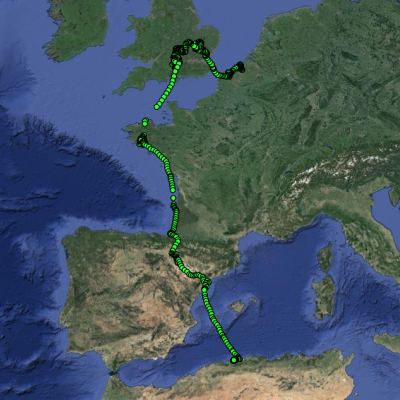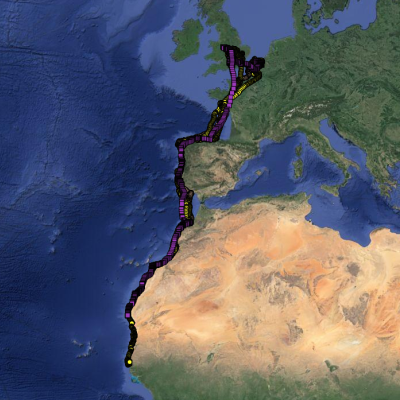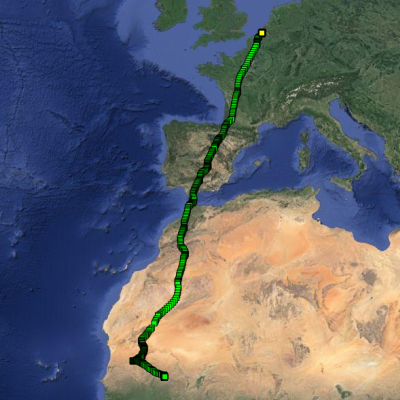You are here
Autumn migration 2014-2015
|
In the course of August-November 2014, most of the Lesser Black-backed Gulls started their autumn migration and exchanged their breeding grounds in Zeebrugge for their winter grounds in the South of Spain and Portugal and North Africa. By the end of November, most of the gulls left Flanders, with one exception, Katrien, who left only late December. Some birds traveled over land, while others seemed to prefer to follow the coastlines. In the course of September 2014, also the Western Marsh Harriers started traveling south to their winter grounds in Northwest Africa. By clicking on the map on the right, you are redirected to an interactive map displaying the autumn migration of 2014 of the Lesser Black-backed Gulls. Below you can read some peculiar travel stories. |
|
Last year, Harry (719), a male Lesser Black-backed Gull, made a trip to the UK before heading south for the winter season. His UK trip must have been so memorable he told his friends, because this year, several gulls followed him: Angel (5073) (♀), Ella (5063) (♀), Katrien (1402) (♀), Roxanne (5065) (♀), Sjarel (4045) (♂) and Steven (4040) (♂) all spent a few weeks foraging (read: partying) in the UK before their southward journey. Harry, Steven and Sjarel, the males, were the first ones to exchange the UK for the South. A little later the females followed. Katrien, however, was foraging (read: partying) too hard and only realized by the end of December 2014 that the UK was actually too cold. She immediately flew to Casablanca, where she continued foraging (read: partying)... For an animated visualization of the gulls visiting the UK, click on the image on the left. |
||
|
Although most Lesser Black-backed Gulls travel to the South of Spain and Portugal for the winter season, Roxanne (5065), a female Lesser Black-backed Gull decided to avoid the crowds and go to Northern Algeria instead. Around August 25th 2014, she left Flanders for the UK, where she stayed for almost 3 months. By November 23rd 2014, she continued her southward journey, across the English channel, along the French West coast, across the Spanish mainland and Mediterranean Sea, until she reached the northern shores of Algeria one week later. For an animated visualization of Roxanne's alternative route, click on the image on the left. |
||
|
Ian (5071) (♂), Matt (5072) (♂), Steven (4040) (♂) and Sanne (833) (♀), four Lesser Black-backed Gulls, decided to travel a little further than the usual winter hangout spots for gulls. While Sanne, Ian and Matt immediately started the race, Steven first spent a few months in the UK. From the start, Sanne took the lead, and she flew straight to the Senegalese coast, even beyond Dakar. Ian and Matt however only made it to the West Saharan coast (around Dakhla). By the end of October 2014, when the other contestants long reached their destination, Steven finally decided it was time to enter the race. But to no avail, he had to settle for second place: after a few stops in Casablanca, El-Aaiún and Dakhla, he only made it to the southern border of the Western Sahara. So, It seems Sanne is the obvious winner! For an animated visualization of these seasoned travelers, click on the image on the left. |
||
|
Although Lesser Black-backed Gulls are generally believed to be migratory birds, it seems as if Yente (5060) (♀) only traveled as far as the Northern part of France during the winter season of 2014-2015, and chose the vicinity of Paris as her wintering sport. However, this cannot be said with certainty, since the track data for Yente is incomplete. For an animated visualization of Yente's whereabouts, click on the image on the left. |
||
|
Jozef (610), a male Western Marsh Harrier, traveled to the almost exact same wintering spot as last year, at the southern border of Mauritania with Mali. He left Flanders around August 27th 2014, and reached his final destination by October 10th 2014. For Peter (623), the other male Western Marsh Harrier, however, the signal was lost. It is most likely this bird died. For an animated visualization of Jozef's trip, click on the image on the left. |
||
|
Most Herring Gulls, not being migratory birds, stayed in Flanders during the winter of 2014-2015. Several birds however, visited Northern France on a regular basis, e.g. Leslie (6013) (♀), Stephanie (6036) (♀) and Wendy (6037) (♀) resided at the Boulonnais coast, and Roeland (6002) (♂) even traveled as far as Normandy. Several other Herring Gulls (Jan (6001) (♂), Karen (6003) (♀), Klaas (6070) (♂), Luc (799) (♂), and Wilma (783) (♀)), regularly visited the site of a waste treatment facility (Baudelet Environnement) in Blaringhem. The bravest bird of the bunch however must be Magda (6043) (♀), who crossed the pond and even traveled to the UK during the winter of 2014-2015! For an animated visualization of the wintering Herring Gulls, click on the image on the left. |
||
|
During the winter season of 2014-2015 (December to February), the three bird species had different winter locations. The Lesser Black-backed Gulls left cold Flanders for warmer places and could be found in the vicinity of Coimbra, Lisbon, Sevílla, Málaga, Tanger, Casablanca, and along the coasts of Algeria, Western Sahara, and Mauritania. Also the Western Marsh Harriers traveled south and were located in Northwest Africa, as far as the Southern border of Mauritania. The European Herring Gulls, not being migratory birds, didn't leave their breeding grounds and remained in Ostend, although some of them could be found in the vicinity of Paris and in Normandy. To see where the birds spent their winter, click on the image on the left. |








